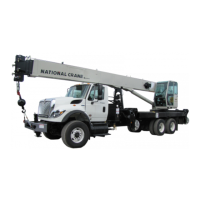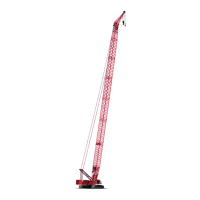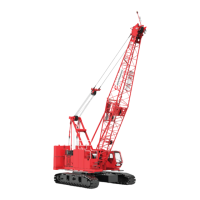INTRODUCTION 14000 SERVICE MANUAL
1-26
Published 09-10-14, Control # 065-24
SWING SYSTEM
See Figure 1-16 and Figure 1-17 for the following procedure.
One hydraulic swing pump drives one swing motor. The
hydraulic motor drives a gearbox that meshes with tooth
gears that turns rotating bed to swing. Swing system is
controlled with swing control handle movement and node
controllers. Swing control handle is inoperable when swing
brake is applied. Rotating bed is free to coast if swing control
handle is in neutral position and swing brake is released.
Swing motor is fixed displacement and controlled directly by
output fluid volume of swing pump as controlled by handle
command. Swing pressure senders monitor pressure for
both swing left and swing right sides of closed loop system.
An orifice across swing motor ports A and B allow smooth
fluid flow when shifting swing directions. Continuous
changing of closed-loop fluid occurs through leakage in
pumps and motors.
When in a swinging motion, the preferred way to stop or slow
the crane is to move swing control handle beyond center in
the opposite direction. This allows rotating bed to gradually
stop.
Swing speed and swing torque can be selected for type of
work being performed on Function Mode screen (see
Section 3 of this manual).
When swing control handle is moved from off, an input signal
is sent to node 1 controller. Node 4 controller sends a 24 volt
signal to enable right side and left side swing/travel alarm.
When swing control handle is moved to off, an input signal is
sent to node 1 controller. Node 3 controller sends a zero volt
output signal to disable right side and left side swing/travel
alarm.
Swing Brake
Swing system has a spring-applied hydraulically released
brake on drive shaft.
The source hydraulic pressure for releasing swing brake is
from drum 3/left travel charge pump at approximately 350 psi
(24 bar). Swing brake system pressure must be above 200
psi (14 bar) to fully release brake. If system pressure is below
200 psi (14 bar), swing brake could be partially applied and
damage swing system. If brake pressure or electrical power
is lost when operating, swing brake applies.
After startup, place swing brake switch in off - park position.
An input voltage is sent to node 1 controller. Node 3
controller sends a 24 volt output to enable swing brake
solenoid HS-14. Swing brake valve shifts to hydraulically
release swing brake from shaft.
Before shutdown or to prevent swing movement, place swing
brake switch in on - park position. An input voltage is sent to
node 1 controller. Node 3 controller sends a zero output
voltage to disable swing brake solenoid HS-14. Swing brake
valve shifts to block fluid to brake and swing brake applies.
Fluid from brake flows to tank.
Swing Left
See Figure 1-16 and Figure 1-17 for the following procedure.
When swing control handle is moved to the left, an input
voltage of 2.4 volts or less is sent to node 1 controller. Node 4
controller sends a variable 0 to 24 volt output that is divided
by resistors and applied to swing pump EDC. Pump EDC tilts
swashplate relative to handle movement and direction.
Hydraulic fluid flows from pump outlet port B to motor inlet
port, moving rotating bed to left. Hydraulic return fluid from
motor outlet port flows to pump inlet port A.
As swing control handle is moved to neutral position, node 1
controller compensates for hydraulic system leakage or
changing engine speed. Node 4 controller sends a zero
output voltage to move pump swashplate to center position.
Swing Right
When swing control handle is moved to the right, an input
voltage of 2.6 volts or more is sent to node 1 controller.
Node 4 controller sends a variable 0 to 24 volt output that is
divided by resistors and applied to swing pump EDC.
Hydraulic fluid flows from pump outlet port A to motor inlet
port, moving rotating bed to the right. Hydraulic return fluid
from motor outlet port flows to pump inlet port B, completing
closed-loop circuit.
As swing control handle is moved to neutral position, node 1
controller compensates for hydraulic system leakage or
changing engine speed. Node 4 controller sends a zero
output voltage to move pump swashplate to center position.
Swing Holding Brake Switch
Swing holding brake switch on side of swing control handle,
holds rotating bed in position (applies swing park brake) for
short periods when operating. To prevent damage to swing
system, swing holding brake switch must only be applied
when crane is at a standstill.
When swing holding brake switch is pressed in and held, an
input voltage is sent to node 1 controller. Node 3 controller
sends a zero output voltage to shift swing brake solenoid HS-
14 to on - park position. Swing brake valve shifts to block
fluid to brake and swing brake is applied.
When swing holding brake switch is released, an input
voltage is sent to node 1 controller. Node 3 controller sends a
24 volt output to shift swing brake solenoid HS-14 to off -
park position. Swing brake valve shifts, allowing system
pressure to hydraulically release park brake.

